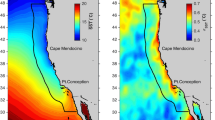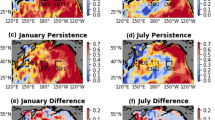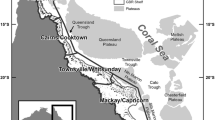Abstract
The skill of monthly sea surface temperature (SST) anomaly predictions for large marine ecosystems (LMEs) in coastal regions of the United States and Canada is assessed using simulations from the climate models in the North American Multimodel Ensemble (NMME). The forecasts based on the full ensemble are generally more skillful than predictions from even the best single model. The improvement in skill is particularly noteworthy for probability forecasts that categorize SST anomalies into upper (warm) and lower (cold) terciles. The ensemble provides a better estimate of the full range of forecast values than any individual model, thereby correcting for the systematic over-confidence (under-dispersion) of predictions from an individual model. Probability forecasts, including tercile predictions from the NMME, are used frequently in seasonal forecasts for atmospheric variables and may have many uses in marine resource management.









Similar content being viewed by others
References
Alexander MA, Deser C (1995) A mechanism for the recurrence of midlatitude SST anomalies during winter. J Phys Oceanogr 25:122–137
Anderson DLT et al (2003) Comparison of the ECMWF seasonal forecast system 1 and 2, including the relative performance for the 1997/8 El Nino. Tech. Memo. 404. ECMWF, Reading, pp 93
Barnston AG (1994) Linear statistical short-term climate predictive skill in the Northern Hemisphere. J Clim 7:1513–1564. doi:10.1175/1520-0442(1994)007<1513:LSSTCP>2.0.CO;2
Barth JA, Menge BA, Lubchenco J, Chan F, Bane JM, Kirincich AR, McManus MA, Nielsen KJ, Pierce SD, Washburn L (2007) Delayed upwelling alters nearshore coastal ocean ecosystems in the northern California current. Proc Natl Acad Sci 104:3719–3724
Becker E, van den Dool HM (2016) Probabilistic seasonal forecasts in the North American multi model ensemble: a baseline skill assessment. J Clim 29:3015–3026. doi:10.1175/JCLI-D-14-00862.1
Becker E, van den Dool HM, Zhang Q (2014) Predictability and forecast skill in NMME. J Clim 27:5891–5906. doi:10.1175/JCLI-D-13-00597.1
Blanchard-Wrigglesworth E, Armour KC, Bitz CM, DeWeaver E (2011) Persistence and Inherent Predictability of Arctic Sea Ice in a GCM Ensemble and Observations. J Clim 24(1):231–250
Boyer TP et al (2013) World ocean database 2013. NOAA Atlas NESDIS 72. Levitus S, Ed Mishonov A (eds) Silver Spring, pp 209. doi:10.7289/V5NZ85MT
Brier GW (1950) Verification of forecasts expressed in terms of probability. Mon Weather Rev 78:1–3
Buizza R (1997) Potential forecast skill of ensemble prediction and spread and skill distributions of the ECMWF Ensemble Prediction System. Mon Weather Rev 125:99–119. doi:10.1175/1520-0493(1997)125<0099:PFSOEP>2.0.CO;2
DelSole T, Yang X, Tippett MK (2013) Is unequal weighting significantly better than equal weighting for multi-model forecasting? Q J R Meteorol Soc 139:176–183. doi:10.1002/qj.1961
Delworth TL et al (2006) GFDL’s CM2 global coupled climate models. Part I: formulation and simulation characteristics. J Clim 19:644–667
Derber J, Rosati A (1989) A global oceanic data assimilation system. J Phys Oceanogr 19:1333–1347
DeWitt DG (2005) Retrospective forecasts of interannual sea surface temperature anomalies from 1982 to present using a directly coupled atmosphere–ocean general circulation model. Mon Weather Rev 133:2972–2995
Eveson JP et al (2015) Seasonal forecasting of tuna habitat in the Great Australian Bight. Fish Res 170:39–49
Goddard L, Mason SJ, Zebiak SE, Ropelewski CF, Basher R, Cane MA (2001) Current approaches to seasonal-to-interannual climate predictions. Int J Climatol 21:1111–1152
Hagedorn R, Doblas-Reyes FJ, Palmer TN (2005) The rationale behind the success of multi-model ensembles in seasonal forecasting—I. Basic concept. Tellus A 57:219–233. doi:10.1111/j.1600-0870.2005.00103.x.
Hobday AJ, Hartog JR (2014) Derived ocean features for dynamic ocean management. Oceanography 27(4):134–145. doi:10.5670/oceanog.2014.92
Hobday AJ et al (2011) Ecological risk assessment for the effects of fishing. Fish Res 108:372–384. doi:10.1016/j.fishres.2011.01.013
Infanti JM, Kirtman BP (2016) Prediction and predictability of land and atmosphere initialized CCSM4 climate forecasts over North America. J Geophys Res: Atmos 121(21):12690–12701
Jacox MG, Alexander MA, Hervieux G, Stock CA (2017) On the skill of seasonal sea surface temperature forecasts in the California current system and its connection to ENSO variability. Clim Dyn. doi:10.1007/s00382-017-3608-y
Ji M, Behringer DW, Leetmaa A (1998) An improved coupled model for ENSO prediction and implications for ocean initialization. Part II: the coupled model. Mon Weather Rev 126:1022–1034
Jin EK et al. (2008) Current status of ENSO prediction skill in coupled ocean–atmosphere model. Clim Dyn 31(6):647–664. doi:10.1007/s00382-008-0397-3.
Jolliffe IT, Stephenson DB (2003) Forecast verification: a practitioner’s guide in atmospheric science. Wiley, Chichester, p 240
Kirtman BP et al (2014) The North American multimodel ensemble phase-1 seasonal-to-interannual prediction; phase-2 toward developing intraseasonal prediction. Bull Am Meteorol Soc 95:585–601. doi:10.1175/BAMS-D-12-00050.1
Kirtman BP, Min D (2009) Multimodel ensemble ENSO prediction with CCSM and CFS. Mon Weather Rev 137:2908–2930
Kirtman BP, Zebiak SE (1997) ENSO simulation and prediction with a hybrid coupled model. Mon Weather Rev 125:2620–2641. doi:10.1175/1520-0493(1997)125\2620:ESAPWA[2.0.CO;2
Koh T-Y, Wang S, Bhatt BC (2012) A diagnostic suite to assess NWP performance. J Geophys Res 117:D13109. doi:10.1029/2011JD017103
Latif M, Barnett TP, Cane MA, Flugel M, Graham NE, von Storch H, Xu JS, Zebiak SE (1994) A review of ENSO prediction studies. Clim Dyn 9:167–179. doi:10.1007/BF00208250.
Merryfield WJ et al (2013) The Canadian seasonal to interannual prediction system. Part I: models and initialization. Mon Weather Rev 141:2910–2945
Murphy AH (1973) A New Vector Partition of the Probability Score. J Appl Meteorol 12(4):595–600
National Research Council (2010) Assessment of intraseasonal to interannual climate prediction and predictability. The National Academies Press, Washington, DC. doi:10.17226/12878
Palmer TN et al (2004) Development of a European multimodel ensemble system for seasonal-to-interannual prediction (DEMETER). Bull Am Meteorol Soc 85:853–872. doi:10.1175/BAMS-85-6-853
Pörtner HO, Farrell AP (2008) Physiology and climate change. Science 322:690–692
Pörtner HO, Peck MA (2010) Climate change effects on fishes and fisheries: towards a cause-and-effect understanding. J Fish Biol 77:1745–1779
Raftery AE, Gneiting T, Balabdaoui F, Polakowski M (2005) Using Bayesian model averaging to calibrate forecast ensembles. Mon Weather Rev 133:1155–1174
Reynolds RW, Smith TM, Liu C, Chelton DB, Casey KS, Schlax MG (2007) Daily high-resolution-blended analyses for sea surface temperature. J Clim 20:5473–5496
Rosati A, Miyakoda K, Gudgel R (1997) The impact of ocean initial conditions on ENSO forecasting with a coupled model. Mon Weather Rev 125:754–772
Saba VS, Griffes SM, Anderson WG, Winton M, Alexander MA, Delworth TL, Hare JA, Harrison MJ, Rosati A, Vechhi GA, Zhang R (2016) Enhanced warming of the Northwest Atlantic Ocean under climate change. J Geophys Res Oceans 121:118–132. doi:10.1002/2015JC011346
Saha S et al (2006) The NCEP climate forecast system. J Clim 19:3483–3517
Saha S et al (2014) The NCEP climate forecast system version 2. J Clim 27:2185–2208
Sherman K, Duda AM (1999) An ecosystem approach to global assessment and management of coastal waters. Mar Ecol Prog Ser 190:271–287
Sherman K, Belkin IM, Friedland KD, O'Reilly J, Hyde K (2009) Accelerated Warming and Emergent Trends in Fisheries Biomass Yields of the World's Large Marine Ecosystems. AMBIO: J Hum Environ 38(4):215–224
Siedlecki SA, Kaplan IC, Hermann A, Nguyen T, Bond NA, Williams G, Newton J, Peterson WT, Alin S, Feely RA (2016) Experiments with seasonal forecasts of ocean conditions for the Northern region of the California current upwelling system. Nat Sci Rep 6. doi:10.1038/srep27203
Sooraj KP, Annamalai H, Kumar A, Wang H (2012) A comprehensive assessment of CFS seasonal forecast over the tropics. Weather Forecast 27: 3–27. doi:10.1175/WAF-D-11-00014.1.
Spillman CM, Hartog JR, Hobday AJ, Hudson D (2015) Predicting environmental drivers for prawn aquaculture production to aid improved farm management. Aquaculture 447:56–65
Stock CA, Pegion K, Vecchi GA, Alexander MA, Tommasi D, Bond NA, Fratantoni PS, Gudgel RG, Kristiansen T, O’Brien TD, Xue Y, Yang X (2015) Seasonal sea surface temperature anomaly prediction for coastal ecosystems. Prog Oceanogr 137:219–236. doi:10.1016/j.pocean.2015.06.007
Stockdale TN (1997) Coupled ocean–atmosphere forecasts in the presence of climate drift. Mon Weather Rev 125:809–818
Stockdale TN, Anderson DLT, Alves JOS, Balmaseda MA (1998) Global seasonal rainfall forecasts using a coupled ocean–atmosphere model. Nature 392:370–373
Taylor KA (2001) Summarizing multiple aspects of model performance in a single diagram. J Geophys Res Atmos 106(D7):7183–7192
Tippett MK, Barnston AG (2008) Skill of multimodel ENSO probability forecasts. Mon Weather Rev 136:3933–3946. doi:10.1175/2008MWR2431.1
van den Dool HM, Toth Z (1991) Why do forecasts for “near normal” often fail? Weather Forecast 6:76–85. doi:10.1175/15200434(1991)006<0076:WDFFNO>2.0.CO;2
Vecchi GA et al (2014) On the seasonal forecasting of regional tropical cyclone activity. J Clim 27:7994–8016
Vernieres G, Keppenne C, Rienecker MM, Jacob J, Kovach R (2012) The GEOS-ODAS, description and evaluation. NASA technical report series on global modeling and data assimilation, NASA/TM–2012–104606, vol 30
Wang B et al (2009) Advance and prospectus of seasonal prediction: assessment of the APCC/CliPAS 14-model ensemble retrospective seasonal prediction (1980–2004). Clim Dyn 33:93–117. doi:10.1007/s00382-008-0460-0
Weigel AP, Liniger MA, Appenzeller C (2008) Can multi-model combination really enhance the prediction skill of probabilistic ensemble forecasts? Q J R Meteorol Soc 134:241–260. doi:10.1002/qj.210
Wilks DS (1995) Statistical methods in the atmospheric sciences. Academic Press, Dublin, p 467
Yang X et al (2012) A predictable AMO-like pattern in the GFDL fully coupled ensemble initialization and decadal forecasting system. J Clim 26:650–661
Acknowledgements
We thank the NOAA Climate Program Office (CPO) for providing funding for this research. DT was funded by a Special Early-Stage Exploration and Development grant from NOAA’s office of oceanic and atmospheric research (OAR) with additional support from NOAA’s National Marine Fisheries Service.
Author information
Authors and Affiliations
Corresponding author
Additional information
This paper is a contribution to the special collection on the North American Multi-Model Ensemble (NMME) seasonal prediction experiment. The special collection focuses on documenting the use of the NMME system database for research ranging from predictability studies, to multi-model prediction evaluation and diagnostics, to emerging applications of climate predictability for subseasonal to seasonal predictions.This special issue is coordinated by Annarita Mariotti (NOAA), Heather Archambault (NOAA), Jin Huang (NOAA), Ben Kirtman (University of Miami) and Gabriele Villarini (University of Iowa).
Electronic supplementary material
Below is the link to the electronic supplementary material.
Rights and permissions
About this article
Cite this article
Hervieux, G., Alexander, M.A., Stock, C.A. et al. More reliable coastal SST forecasts from the North American multimodel ensemble. Clim Dyn 53, 7153–7168 (2019). https://doi.org/10.1007/s00382-017-3652-7
Received:
Accepted:
Published:
Issue Date:
DOI: https://doi.org/10.1007/s00382-017-3652-7




